4(p-Nitrophenylazo)resorcinol is widely utilized in research focused on:
- Dyes and Pigments: This compound is commonly used in the textile industry as a dye due to its vibrant color properties, providing a cost-effective solution for coloring fabrics.
- Analytical Chemistry: It serves as a reagent in various analytical methods, particularly in the detection of metal ions, enhancing the accuracy of tests in laboratories.
- Biological Research: The compound is employed in studies related to enzyme activity and protein interactions, offering insights into biochemical processes.
- Pharmaceutical Development: It is explored for its potential applications in drug formulation, particularly in creating colorimetric assays for drug testing.
- Environmental Monitoring: Used in assessing water quality, it helps detect pollutants, making it valuable for environmental scientists and regulatory agencies.
General Information
Properties
Safety and Regulations
Applications
4(p-Nitrophenylazo)resorcinol is widely utilized in research focused on:
- Dyes and Pigments: This compound is commonly used in the textile industry as a dye due to its vibrant color properties, providing a cost-effective solution for coloring fabrics.
- Analytical Chemistry: It serves as a reagent in various analytical methods, particularly in the detection of metal ions, enhancing the accuracy of tests in laboratories.
- Biological Research: The compound is employed in studies related to enzyme activity and protein interactions, offering insights into biochemical processes.
- Pharmaceutical Development: It is explored for its potential applications in drug formulation, particularly in creating colorimetric assays for drug testing.
- Environmental Monitoring: Used in assessing water quality, it helps detect pollutants, making it valuable for environmental scientists and regulatory agencies.
Documents
Safety Data Sheets (SDS)
The SDS provides comprehensive safety information on handling, storage, and disposal of the product.
Product Specification (PS)
The PS provides a comprehensive breakdown of the product’s properties, including chemical composition, physical state, purity, and storage requirements. It also details acceptable quality ranges and the product's intended applications.
Certificates of Analysis (COA)
Search for Certificates of Analysis (COA) by entering the products Lot Number. Lot and Batch Numbers can be found on a product’s label following the words ‘Lot’ or ‘Batch’.
*Catalog Number
*Lot Number
Certificates Of Origin (COO)
This COO confirms the country where the product was manufactured, and also details the materials and components used in it and whether it is derived from natural, synthetic, or other specific sources. This certificate may be required for customs, trade, and regulatory compliance.
*Catalog Number
*Lot Number
Safety Data Sheets (SDS)
The SDS provides comprehensive safety information on handling, storage, and disposal of the product.
DownloadProduct Specification (PS)
The PS provides a comprehensive breakdown of the product’s properties, including chemical composition, physical state, purity, and storage requirements. It also details acceptable quality ranges and the product's intended applications.
DownloadCertificates of Analysis (COA)
Search for Certificates of Analysis (COA) by entering the products Lot Number. Lot and Batch Numbers can be found on a product’s label following the words ‘Lot’ or ‘Batch’.
*Catalog Number
*Lot Number
Certificates Of Origin (COO)
This COO confirms the country where the product was manufactured, and also details the materials and components used in it and whether it is derived from natural, synthetic, or other specific sources. This certificate may be required for customs, trade, and regulatory compliance.


